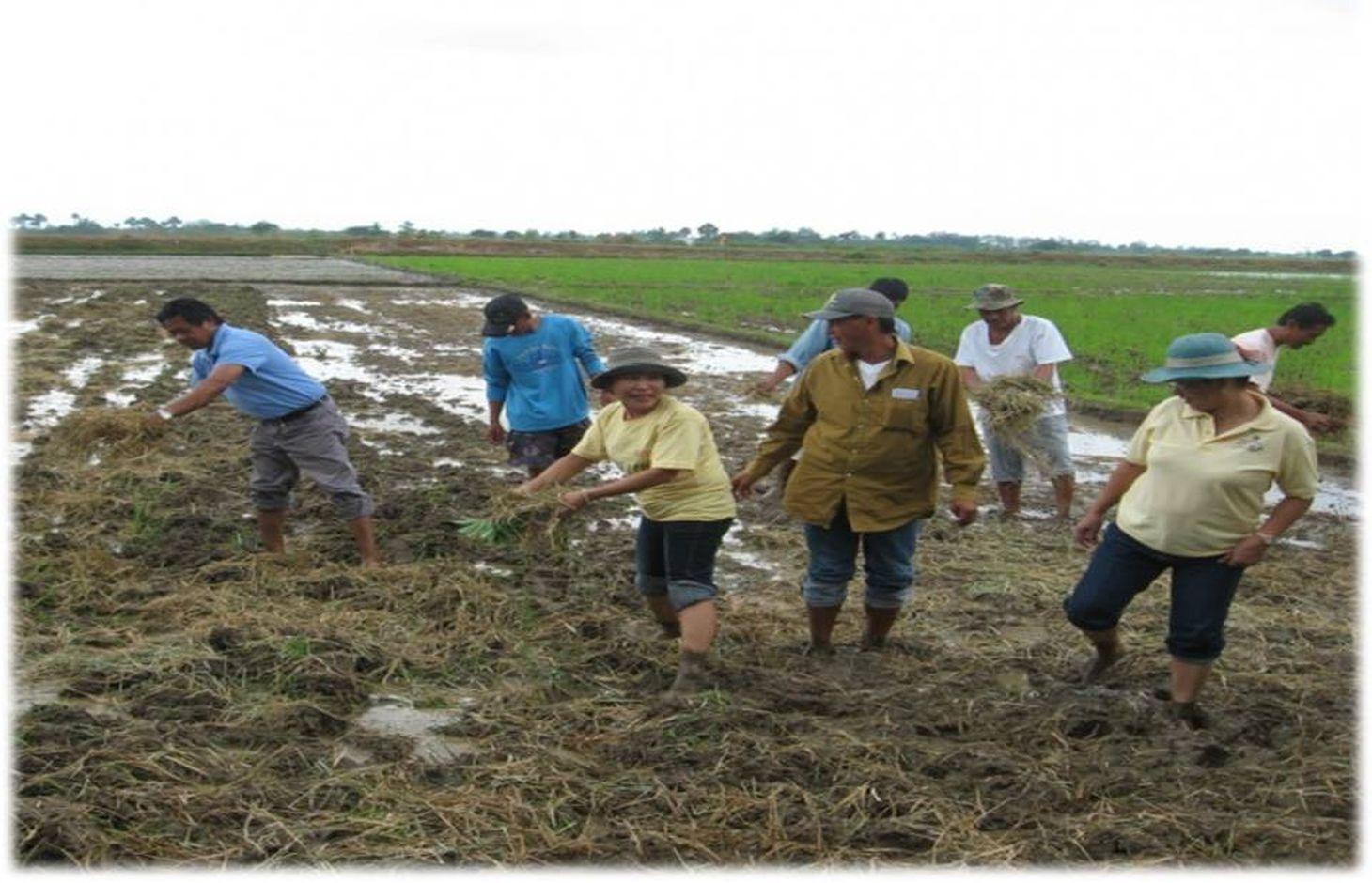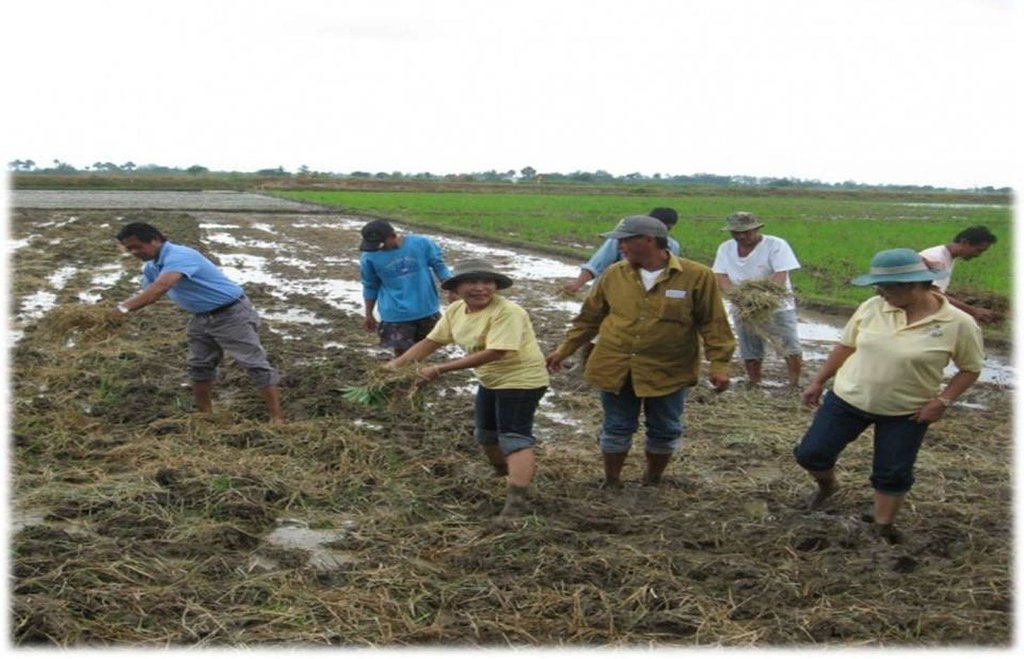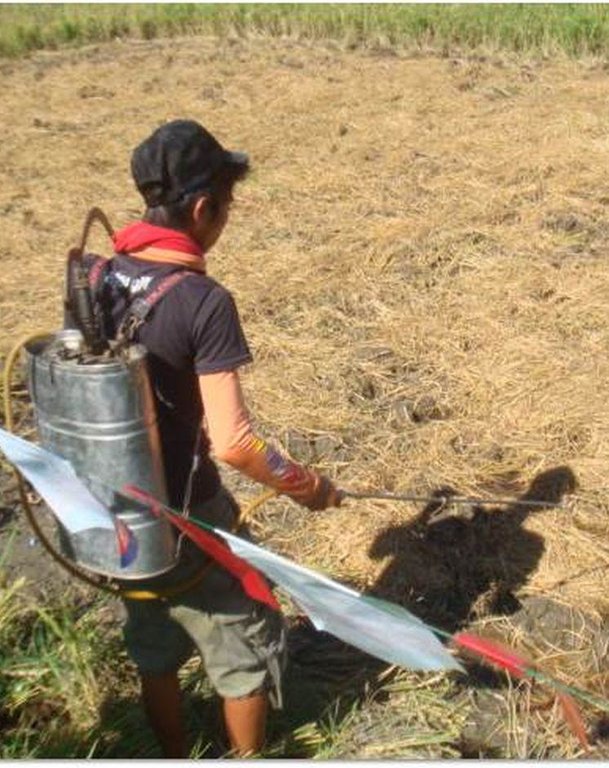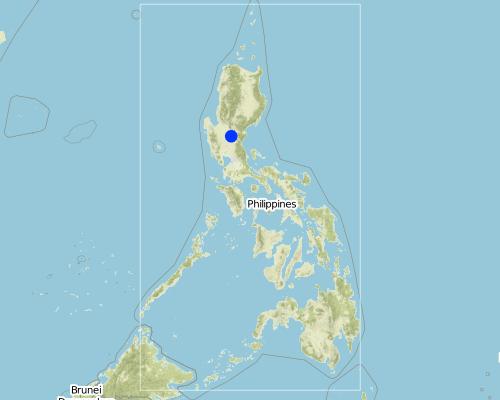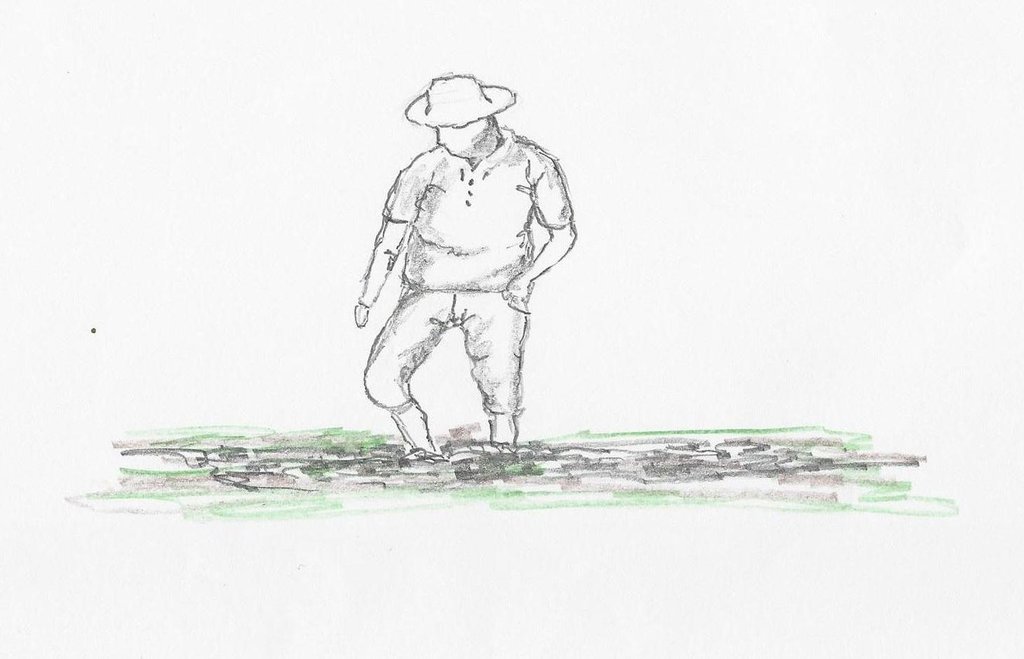Modified Rapid Composting [菲律宾]
- 创建:
- 更新:
- 编制者: Philippine Overview of Conservation Approaches and Technologies
- 编辑者: –
- 审查者: David Streiff
technologies_1295 - 菲律宾
查看章节
全部展开 全部收起1. 一般信息
1.2 参与该技术评估和文件编制的资源人员和机构的联系方式
关键资源人
SLM专业人员:
Dinamling Djolly Ma
DA-BSWM
菲律宾
Raquid Jemar G.
DA-BSWM
菲律宾
SLM专业人员:
Martinez Mamerto F.
DA-BSWM
SLM专业人员:
Clariza Flora V.
菲律宾
有助于对技术进行记录/评估的机构名称(如相关)
Bureau of Soils and Water Management (Bureau of Soils and Water Management) - 菲律宾有助于对技术进行记录/评估的机构名称(如相关)
Local Government Unit of Talavera, Nueva Ecija (LGUT) - 菲律宾1.3 关于使用通过WOCAT记录的数据的条件
(现场)数据是什么时候汇编的?:
22/07/2015
编制者和关键资源人员接受有关使用通过WOCAT记录数据的条件。:
是
2. SLM技术的说明
2.1 技术简介
技术定义:
Modified Rapid Composting is the in situ decomposition of rice straw using compost fungus activator, Trichoderma harzianum or Effective Microorganism, that helps in utilizing the residual Nitrogen-Phosphorus-Potassium (NPK) from the decomposed rice straw.
2.2 技术的详细说明
说明:
In search of reducing the vulnerability of the small farmers to the uncontrolled price of chemical fertilizer as well as the dependency on the usage of it, the Department of Agriculture through Bureau of Soils and Water Management (BSWM) developed a fertilizer cost reduction strategy by introducing a new composting technology that will produce organic compost as substitute and eventually decrease the utilization of chemical fertilizer. This is called Modified Rapid Composting.
It incorporates a farm residue management wherein the rice straw is scattered evenly in the field as compost material with the aid of fungus activator that hastens the decomposition process as compared to the traditional composting method. The compost fungus activators used are Trichoderma harzianum and/or Effective Microorganism. Eventually, this compost is mixed into the soil during land preparation. When decayed, it increases the supply of nutrients and improves soil structure.
Purpose of the Technology: This technology aimed to establish a cost-efficient, competitive and sustainable agricultural production system. It addresses the concern of soil fertility deterioration through organic based fertilization scheme. Further, it reduces vulnerability of small farmers to the uncontrolled prices of chemical fertilizers. It also prevent the unfavorable farmer’s practice of burning the rice straw. This also serves as a promotional tool for the gradual conversion of rice land from conventional to organic-based farming system.
Establishment / maintenance activities and inputs: Primarily, this technology is applied and incorporated as part of the land preparation activity. Shallow plowing/rotavating is done to flatten down rice stubbles. The rice straw is then scattered in the field. Irrigation is applied at about 2-3cm depth. Soak the rice straw in the field approximately for 12 hours. Drain excess water. Spray Trichoderma harzianum solution prepared by dissolving 3 packs/knapsack sprayer (20 packs/hectare) in early morning or late in the afternoon. Effective Microorganism solution can also be used aside from Trichoderma harzianum. Broadcast at least 12 kg urea to hasten decomposition. Maintain sufficient moisture in the rice paddies during the decomposition period (15-20 days). Proceed with the usual land preparation. Apply 10 bags of vermicast/chicken dung at last harrowing as basal application.
Natural / human environment: It is introduced and currently practiced in the irrigated plain rice production areas in the Philippines such as in Talavera, Nueva Ecija. The soil type in Talavera is clay loam. Mostly, farmer associations, with an average farm size of 1.50 ha, comprising of small-scale to medium-scale land users are engaged to apply this technology in their rice areas during wet (May to October) and dry (December to April) season. The average rainfall ranged from 1500-2000 mm.
2.3 技术照片
2.5 已应用该技术的、本评估所涵盖的国家/地区/地点
国家:
菲律宾
区域/州/省:
Talavera, Nueva Ecija
注释:
The practice of MRC is mostly practiced in the irrigated ricefields in Nueva Ecija.
Map
×2.6 实施日期
如果不知道确切的年份,请说明大概的日期:
- 10-50年前
2.7 技术介绍
详细说明该技术是如何引入的:
- 通过项目/外部干预
3. SLM技术的分类
3.2 应用该技术的当前土地利用类型

农田
- 一年一作
主要农作物(经济作物及粮食作物):
Main cash crop: rice
Major food crop: rice
注释:
Major land use problems (compiler’s opinion): soil fertility deterioration
Major land use problems (land users’ perception): soil fertility deterioration
3.3 有关土地利用的更多信息
该技术所应用土地的供水:
- 充分灌溉
注释:
Also Water supply: mixed rainfed - irrigated
每年的生长季节数:
- 2
3.4 该技术所属的SLM组
- 土壤肥力综合管理
3.5 技术传播
具体说明该技术的分布:
- 均匀地分布在一个区域
如果该技术均匀地分布在一个区域上,请注明覆盖的大致区域。:
- 0.1-1 平方千米
3.6 包含该技术的可持续土地管理措施

农艺措施
- A2:有机质/土壤肥力
注释:
Main measures: agronomic measures
Type of agronomic measures: manure / compost / residues
3.7 该技术强调的主要土地退化类型

化学性土壤退化
- Cn:肥力下降和有机质含量下降(非侵蚀所致)
- Ca:酸化
注释:
Main type of degradation addressed: Cn: fertility decline and reduced organic matter content
Secondary types of degradation addressed: Ca: acidification
Main causes of degradation: soil management (heavy application of chemical fertlizers), poverty / wealth (increase farm income)
3.8 防止、减少或恢复土地退化
具体数量名该技术与土地退化有关的目标:
- 减少土地退化
注释:
Main goals: mitigation / reduction of land degradation
4. 技术规范、实施活动、投入和成本
4.1 该技术的技术图纸
4.2 技术规范/技术图纸说明
Spreading of rice straw in the rice field.
Location: Talavera, Nueva Ecija
Date: July 23, 2016
Technical knowledge required for field staff / advisors: moderate
Technical knowledge required for land users: moderate
Main technical functions: increase in nutrient availability (supply, recycling,…)
Secondary technical functions: increase in organic matter
Manure / compost / residues
Material/ species: rice straw
Remarks: scattered in the field
4.3 有关投入和成本计算的一般信息
具体说明成本计算所用货币:
- 美元
注明雇用劳工的每日平均工资成本:
2.22
4.6 维护/经常性活动
| 活动 | 措施类型 | 时间/频率 | |
|---|---|---|---|
| 1. | scattering of rice straw | 农业学的 | before land preparation |
| 2. | spraying of Effective Microorganism solution | 农业学的 | after scattering of rice straw |
4.7 维护/经常性活动所需要的费用和投入(每年)
| 对投入进行具体说明 | 单位 | 数量 | 单位成本 | 每项投入的总成本 | 土地使用者承担的成本% | |
|---|---|---|---|---|---|---|
| 劳动力 | Scattering of rice Straw | Person/day | 10.0 | 2.22 | 22.2 | 100.0 |
| 劳动力 | spraying of Effective Microorganism solution | Person/day | 2.0 | 2.22 | 4.44 | 100.0 |
| 肥料和杀菌剂 | Effective Microorganism solution | Liters | 6.0 | 2.222 | 13.33 | |
| 技术维护所需总成本 | 39.97 | |||||
5. 自然和人文环境
5.1 气候
年降雨量
- < 250毫米
- 251-500毫米
- 501-750毫米
- 751-1,000毫米
- 1,001-1,500毫米
- 1,501-2,000毫米
- 2,001-3,000毫米
- 3,001-4,000毫米
- > 4,000毫米
农业气候带
- 潮湿的
Thermal climate class: tropics
5.2 地形
平均坡度:
- 水平(0-2%)
- 缓降(3-5%)
- 平缓(6-10%)
- 滚坡(11-15%)
- 崎岖(16-30%)
- 陡峭(31-60%)
- 非常陡峭(>60%)
地形:
- 高原/平原
- 山脊
- 山坡
- 山地斜坡
- 麓坡
- 谷底
垂直分布带:
- 0-100 m a.s.l.
- 101-500 m a.s.l.
- 501-1,000 m a.s.l.
- 1,001-1,500 m a.s.l.
- 1,501-2,000 m a.s.l.
- 2,001-2,500 m a.s.l.
- 2,501-3,000 m a.s.l.
- 3,001-4,000 m a.s.l.
- > 4,000 m a.s.l.
说明该技术是否专门应用于:
- 不相关
5.3 土壤
平均土层深度:
- 非常浅(0-20厘米)
- 浅(21-50厘米)
- 中等深度(51-80厘米)
- 深(81-120厘米)
- 非常深(> 120厘米)
土壤质地(表土):
- 中粒(壤土、粉土)
表土有机质:
- 中(1-3%)
5.4 水资源可用性和质量
地下水位表:
5-50米
地表水的可用性:
好
水质(未处理):
良好饮用水
5.5 生物多样性
物种多样性:
- 低
5.6 应用该技术的土地使用者的特征
生产系统的市场定位:
- 生计(自给)
- 混合(生计/商业
非农收入:
- 收入的10-50%
相对财富水平:
- 平均水平
个人或集体:
- 个人/家庭
机械化水平:
- 畜力牵引
- 机械化/电动
性别:
- 女人
- 男人
说明土地使用者的其他有关特征:
Land users applying the Technology are mainly common / average land users
Population density: > 500 persons/km2
Annual population growth: 1% - 2%
5.7 应用该技术的土地使用者拥有或租用的平均土地面积
- < 0.5 公顷
- 0.5-1 公顷
- 1-2 公顷
- 2-5公顷
- 5-15公顷
- 15-50公顷
- 50-100公顷
- 100-500公顷
- 500-1,000公顷
- 1,000-10,000公顷
- > 10,000公顷
这被认为是小规模、中规模还是大规模的(参照当地实际情况)?:
- 小规模的
5.8 土地所有权、土地使用权和水使用权
土地所有权:
- 个人,有命名
土地使用权:
- 自由进入(无组织)
5.9 进入服务和基础设施的通道
健康:
- 贫瘠
- 适度的
- 好
教育:
- 贫瘠
- 适度的
- 好
技术援助:
- 贫瘠
- 适度的
- 好
就业(例如非农):
- 贫瘠
- 适度的
- 好
市场:
- 贫瘠
- 适度的
- 好
能源:
- 贫瘠
- 适度的
- 好
道路和交通:
- 贫瘠
- 适度的
- 好
饮用水和卫生设施:
- 贫瘠
- 适度的
- 好
金融服务:
- 贫瘠
- 适度的
- 好
6. 影响和结论性说明
6.1 该技术的现场影响
社会经济效应
生产
作物生产
收入和成本
农业投入费用
农业收入
社会文化影响
食品安全/自给自足
社区机构
冲突缓解
生态影响
土壤
养分循环/补给
土壤有机物/地下C
生物多样性:植被、动物
害虫/疾病控制
减少气候和灾害风险
碳和温室气体的排放
6.3 技术对渐变气候以及与气候相关的极端情况/灾害的暴露和敏感性(土地使用者认为的极端情况/灾害)
气候有关的极端情况(灾害)
气候灾害
| 该技术是如何应对的? | |
|---|---|
| 干旱 | 不好 |
水文灾害
| 该技术是如何应对的? | |
|---|---|
| 比较和缓的(河道)洪水 | 不好 |
6.4 成本效益分析
技术收益与技术建立成本相比如何(从土地使用者的角度看)?
短期回报:
积极
长期回报:
积极
技术收益与技术维护成本/经常性成本相比如何(从土地使用者的角度看)?
短期回报:
积极
长期回报:
积极
6.5 技术采用
- 大于 50%
如若可行,进行量化(住户数量和/或覆盖面积):
100 household and the area was around 0.1-1km^2
在所有采用这项技术的人当中,有多少人是自发地采用该技术,即未获得任何物质奖励/付款?:
- 10-50%
注释:
76% of land user families have adopted the Technology with external material support
Comments on acceptance with external material support: Since the technology is introduced as a project of the government, the farmer-beneficiaries obtained external material support
24% of land user families have adopted the Technology without any external material support
There is a moderate trend towards spontaneous adoption of the Technology
6.7 该技术的优点/长处/机会
| 土地使用者眼中的长处/优势/机会 |
|---|
|
Environment-friendly since it prevent the farmers from burning the rice straw How can they be sustained / enhanced? Increase advocacy campaign |
| 编制者或其他关键资源人员认为的长处/优势/机会 |
|---|
|
Positive impact/feedback from the farmers on the reduction and elimination on the use of chemical fertilizers. Less inorganic fertilizer usage resulted to decreased in the production costs since inorganic fertilizer are very much expensive. It also enhanced the characteristics of the soil according to the farmer’s observation. How can they be sustained / enhanced? Boost awareness of the farmers on the benefits of organic-based farming |
|
Educate the farmers to become resourceful in terms of utilizing organic materials as fertilizer instead of depending on the commercially available in the market How can they be sustained / enhanced? Intensify or strengthening the campaign of not burning rice straw |
6.8 技术的弱点/缺点/风险及其克服方法
| 编制者或其他关键资源人员认为的弱点/缺点/风险 | 如何克服它们? |
|---|---|
| Additional farm labor particularly in the scattering of rice straw and spraying of compost fungus activator so some farmers still opt to burn the rice straw. | Increase advocacy campaign |
链接和模块
全部展开 全部收起链接
无链接
模块
无模块


